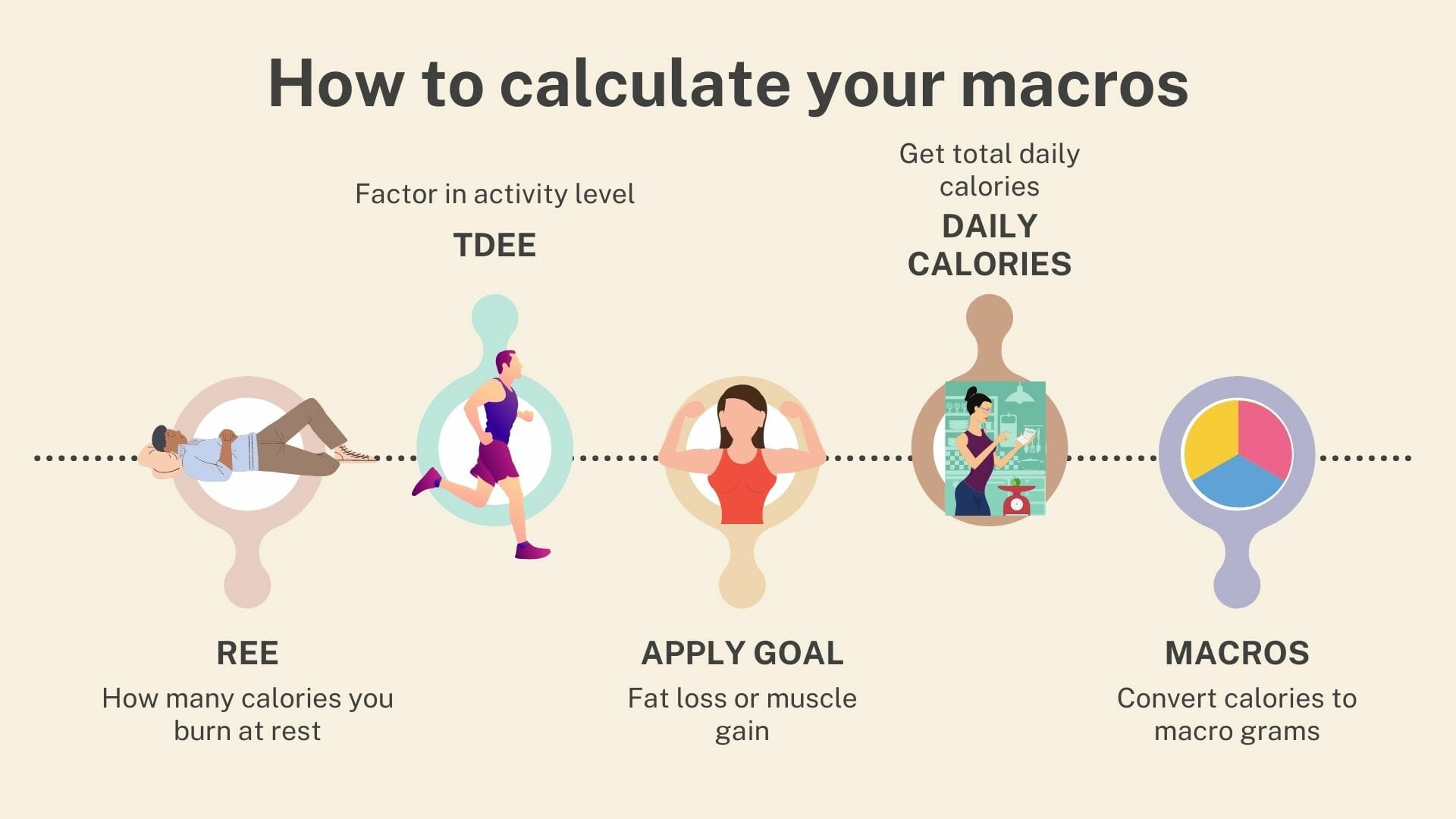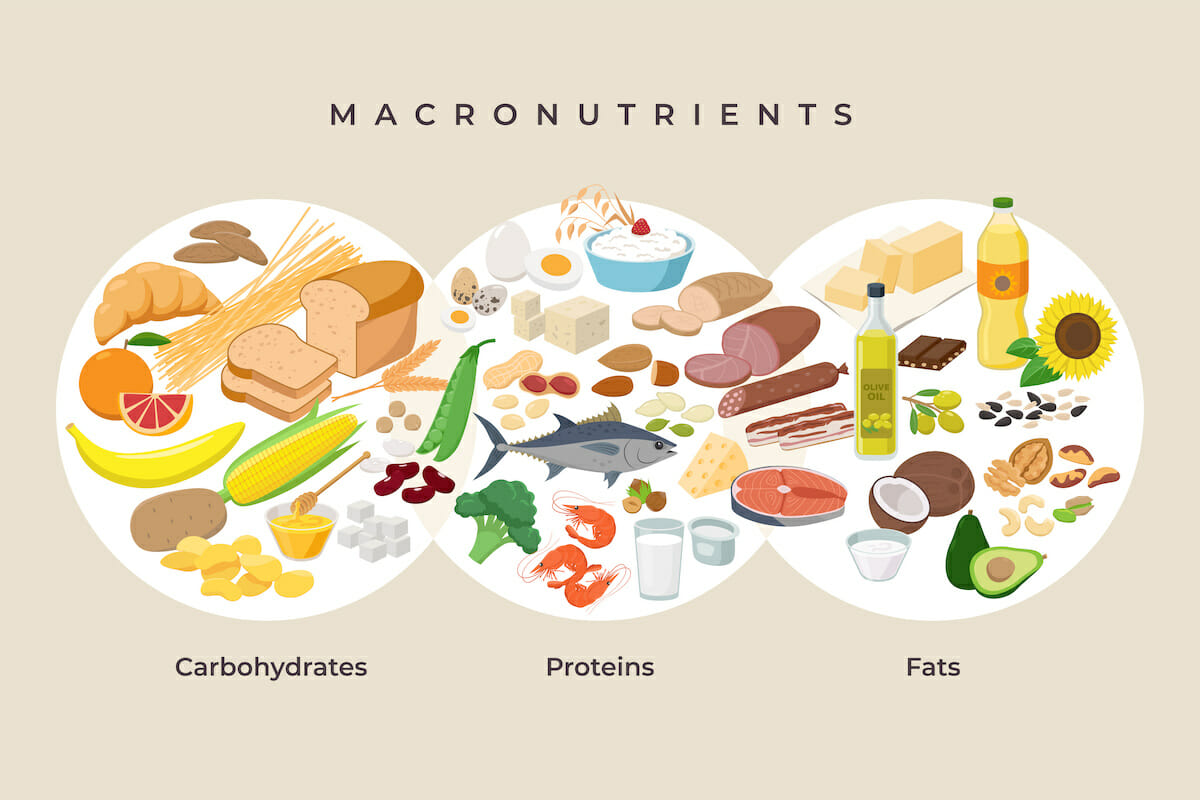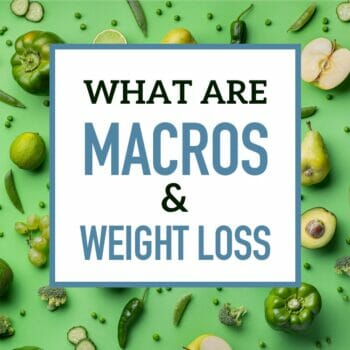How to Calculate Your Macros for Body Transformation
Understanding macros, the formula for calculating macros and your REE, is highly effective for helping you reach your body transformation goals.
The basics of macro counting
If you’re new to counting macros, here are the basic principles:
- The word macro is short for macronutrient.
- The three macronutrients are protein, fat, and carbohydrates.
- Macros are the basis of all the calories (energy) you consume.
- Protein contains 4 calories in each gram.
- Carbs have 4 calories in each gram.
- Fat has 9 calories in each gram.
The philosophy behind macro counting is the idea of flexible dieting.
A flexible diet is free from food restrictions. Yes, you can eat chocolate – provided you stay within your daily macro targets.
Understanding how to calculate and adjust your daily macro goals is one of the most important aspects of a macro diet.
Everybody is different (yes, you are a unique snowflake), so most experienced macro coaches will make adjustments as their clients progress.
Your ability to accurately calculate and adjust your macros will largely determine whether you reach your fitness goals and how fast you get there.
Your metabolism, overall health, and lifestyle are vital in how much energy you burn and how much of each macronutrient you should be eating.
Beginner’s guide to the macro formula and REE calculation
The most important thing to calculate is your REE (Resting Energy Expenditure) and your TDEE (Total Daily Energy Expenditure).
You can quickly calculate your TDEE here, but it’s the number of calories your particular body burns in a day.
Eat less than this means losing weight, and eating more means gaining weight. We call this energy balance.
- Negative energy balance = weight loss
- Positive energy balance = weight gain

The formula for calculating your REE
The Mifflin-St Jeor formula is one of the most popular and respected macro formulas used to calculate your Resting Energy Expenditure (REE). Your REE is the energy it takes to run your body without movement.
Step 1: REE Formula
REE formula for men
10 x weight (kg) + 6.25 x height (cm) – 5 x age (y) + 5 = REE
REE formula for women
10 x weight (kg) + 6.25 x height (cm) – 5 x age (y) – 161 = REE
Tip: Remember your high school math lesson about Order of Operations: (PEMDAS from left to right) when solving the equation for yourself.
Since most people don’t lie in bed all day doing absolutely nothing, we must figure out movement expenditure or TDEE.
Step 2: TDEE Formula
You must assess your activity level.
- Sedentary
Just everyday activities like a bit of walking, a couple of flights of stairs, eating, talking, etc. (REE X 1.2) - Light activity
Any activity that burns an additional 200-400 calories for females or 250-500 calories for males. (REE x 1.375) - Moderate activity
Any activity that burns an additional 400-650 calories for females or 500-800 calories for males. (REE x 1.55) - Very Active
Any activity that burns an additional 650+ calories for females or 800+ calories for males. (REE x 1.725)
A typical TDEE equation could look like this:
Let’s say you’re a 29-year-old, 183 cm, 88 kg, very active male.
Here’s your equation with results rounded to the nearest whole number:
- 10 x weight (kg) + 6.25 x height (cm) – 5 x age (y) + 5 = REE
- 10 x 88 + 6.25 x 183 – 5 x 29 + 5 = REE
- 880 + 1144 – 145 + 5 = 1884 (REE)
- The multiply by 1.725 to get TDEE
- 1884 x 1.725 = 3250 (very active TDEE)
Your TDEE would be around 3,250 Calories.
- Eat more than this = weight gain.
- Eat less than this = weight loss.
- Eat this amount = weight maintenance.
It’s sometimes not as black and white for all people, but for simplicity’s sake, let’s imagine it is.
How do I calculate macros for weight loss?
To lose weight, you need to be in a calorie deficit.
Aim for a calorie deficit of 20%.
Some people recommend reducing your calorie intake by 500 calories. Dropping 500 calories is not good advice as it is not customized to your body type.
For example, if you eat 3,250 calories a day, 20% would be 650 calories, reducing your calorie intake to 2,600 calories a day.
Weight loss TDEE = 3,250 - (3250 x .20) = 2,600 Calories
How do I calculate macros for weight gain (building muscle)?
If you want to gain weight, add between 5% and 20% calories to your overall intake.
At 20%, you’ll likely gain fat and muscle, so starting small and working your way up is vital if you want lean gains.
Using the previous example, this would take calories from 3,250 to 3,900 for weight gain.
Weight gain TDEE = 3,250 + (3250 x .20) = 3,900 Calories
If you hate math, I do all of this for you with my Macro Calculator.
Exceptions to the standard macro formula
- If you are very lean
The standard macro formula isn’t the best if you have low body fat and a high lean body mass. It factors in an average body fat percentage, so those below average will have a lower TDEE calculated than average.
Muscle tissue burns more calories even at rest, so use the “Lean Mass” setting. This uses the more appropriate McArdle, Katch formula. - If you are obese
Having an above-average body fat percentage also skews the standard formula’s results. Fat tissue isn’t active tissue and requires very little energy to maintain itself. Therefore you should consider total fat weight in the equation. Please read more about how counting macros work for obese individuals.
With this knowledge alone, you could get started towards your goal. Counting macros is a very effective way of losing weight (read some of the stories here).
Losing weight and losing fat are two different things (you don’t want to lose muscle). Therefore macronutrient ratios can be important.
What are your ideal macro ratios?

Now that you have your REE and TDEE, you can determine how much of each macronutrient you should consume.
These are the calorie (energy) values for each macronutrient:
- 1 g protein = 4 Calories
- 1 g Carbohydrate = 4 Calories
- 1 g fat = 9 Calories
Calculate how much protein to eat daily
Protein is essential for growing new tissue and fixing broken tissue (what happens when you work out).
Protein is your new best friend if you want to gain or maintain muscle.
Daily protein calories
- When already lean and lifting heavy for bodybuilding, use a measure of 1 g of protein per pound of body weight.
- Most people can use a more balanced approach and .825 g protein per pound since most people carry fat tissue, which skews the “1 gram per pound rule.”
- For people with a lot of excess fat or people who don’t do a lot of strength training, use .65 grams per pound of body weight.
If you struggle to meet your protein targets, use this list of proteins.
So if our individual weighs 195 lbs (88 kg), and they are doing a moderate weight training program, then their protein intake will be 161 grams.
Calculate how much fat you need daily
Fat is often blamed as the reason most of us are, well, fat. But that’s not true.
Healthy fats can be incredibly beneficial for hitting your body composition goals, but they also affect our hormones – too little fat in our diet can be harmful.
Most research (and again, there are a lot of opinions) supports that 20%-30% of overall TDEE calories should come from the fat macro. Let’s use 25% and a middle-of-the-road starting point.
Some people can opt for 30%, especially if you are from a higher fat diet like keto, Paleo, or Atkins.
How to calculate fat grams per day
- 3,250 Calories x 0.25 = 812.5 Calories
- Divide 812.5 by 9 (9 calories per gram of fat) = 90.27g Fat (which I’d round down to 90 g).
Calculate how many carbs (carbohydrates) you need each day
Think of all your favorite foods; chances are they are high in carbohydrates.
Your body uses carbohydrates to make glucose, the preferred fuel or energy our bodies run off, and they’re what keeps us going.
- Carbs don’t make you fat.
- Carbs don’t prevent weight loss.
- Just looking at carbs doesn’t make you gain a pound.
A low-carb diet is a method of placing yourself in a negative energy balance. Counting macros does this through a more scientific approach but without restriction.
Fiber is also a carbohydrate, but the body can use only about 30-40% of it for energy. Some macro counters do track fiber as it’s required for good health.
We’ve sorted protein and fats, but how many carbs do we eat? We allocate the rest of our calories (originally calculated from our TDEE) to carbohydrates.
How to calculate carb grams per day
We started with 3,250 Calories. We allocated 644 calories (161 g) to protein, 813 calories (90 g) to fat and we now allocate the rest, 1793 calories, to carbohydrates.
Since 1g of carb equals 4 calories we divide 1793 by 4 and get 448 g Carbohydrates.
Final macros
161 g protein, 90 g fat, and 448 g carbohydrates for the above example whose target is 3,250 calories per day.
Still Feeling Confused?
Use the macro calculator tool, the TDEE calculator, or see the other fitness calculators to help with the formulas and math.
If you are a woman over 50, please try the menopause macro calculator.
I also offer custom macros and coaching as a certified macros coach.
I’ll analyze your stats and lifestyle factors to dial in your macros as accurately as possible and provide lifetime macro calculation adjustments with some of my plans.
How to convert macro grams to calories
If you ever need to convert your macro grams back to calories, it’s pretty simple.
- 1 g protein = 4 Calories
- 1 g Carbohydrate = 4 Calories
- 1 g fat = 9 Calories
So you multiply the number of grams by the calorie value given.
- 9 grams of protein would have a calorie value of 36. (9 x 4 = 36)
- 9 grams of carbohydrates would have a calorie value of 36. (9 x 4 = 36)
- 9 grams of fat would have a calorie value of 81. (9 x 9 = 81)
How to start losing weight with macros
Beginners can get started with macros by using the above macro calculations and the following two tools.
You’ll be up and running in no time!
- Use a macro tracking app.
You are recording the foods you eat (including their carb, fat, and protein amounts). - Buy a Food Scale
You can weigh unprocessed foods (e.g., a chicken breast). - Learn how to weigh and measure your food.
Can you lose fat and keep muscle?
Yes.
A macro-based diet promotes a sensible calorie deficit of just 20%. This helps your body use its fat reserves but keep your muscle tissue intact.
The protein recommended with counting macros also helps preserve your muscle mass while in a calorie deficit. You can even lose weight and build muscle simultaneously with macro dieting.
Practice makes perfect, and the same is true for beginners and macros. The more you do it, the easier it becomes.
View article sourcesSources
- Mifflin, M. D., St Jeor, S. T., Hill, L. A., Scott, B. J., Daugherty, S. A., & Koh, Y. O. (1990). A new predictive equation for resting energy expenditure in healthy individuals. The American Journal of Clinical Nutrition, 51 (2), 241-247. URL http://www.ajcn.org/content/51/2/241.abstract
- Tipton, K., & Wolfe, R. R. (2001). Exercise, protein metabolism, and muscle growth.
- Fogelholm, M., Anderssen, S., Gunnarsdottir, I., & Lahti-Koski, M. (2012). Dietary macronutrients and food consumption as determinants of long-term weight change in adult populations: a systematic literature review. Food & nutrition research, 56.
- Millward, D. J., Garlick, P. J., Stewart, R. J., Nnanyelugo, D. O., & Waterlow, J. C. (1975). Skeletal-muscle growth and protein turnover. Biochemical Journal, 150(2), 235-243.


 How to track macros with Cronometer
How to track macros with Cronometer What Are The Best Macros For Weight Loss?
What Are The Best Macros For Weight Loss? How To Count Macros on a Vegan, Vegetarian, or Plant-Based Diet
How To Count Macros on a Vegan, Vegetarian, or Plant-Based Diet Out of a Macro For the Day? Here’s What to Eat
Out of a Macro For the Day? Here’s What to Eat Macros for Gaining Muscle and Cutting Fat
Macros for Gaining Muscle and Cutting Fat